Welcome to Artisan Spotlight, a column where we highlight Members’ favorite crafts and tradespeople, showing the work they bring to finished projects as well as the ways they view craftsmanship in a digitized world.
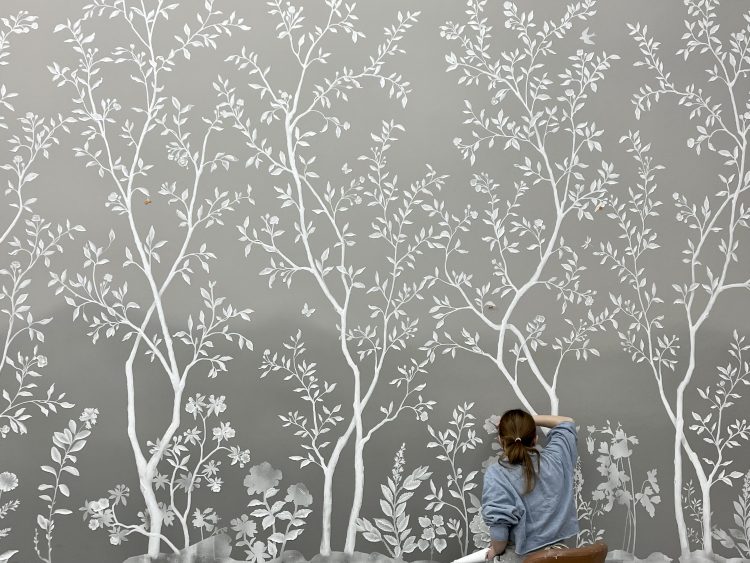
Image courtesy of MJ Atelier
Some 40 years ago Maria Apelo Cruz stepped into the Kips Bay Showhouse on the final day of setup and fell in love with the interior design world. “I just fell in love with the energy, the decorative arts world, and the interior design world,” she says. “And I decided that that’s where I wanted to focus my skills.” Then, she was a student at the New York Academy of Art—now, she is the founder and creative vision behind MJ Atelier, the California studio producing handpainted eglomisé, custom furniture, and bespoke wall treatments, which she has run with her husband, Mike Jovanovic, for the last 12 years. MJ Atelier is perhaps best known for its relief canvas wallpaper which, unlike many three-dimensional wall finishes, can be rolled and shipped worldwide, making it a favorite for designers installing homes around the globe. It’s ideal for showhouses, too—in a bout of continuity, Cruz has created wallcoverings for nearly every Kips Bay showhouse since her first visit. We caught up with her from her studio about classical art training, pushing for handmade design, and her biggest challenges and most exciting projects.
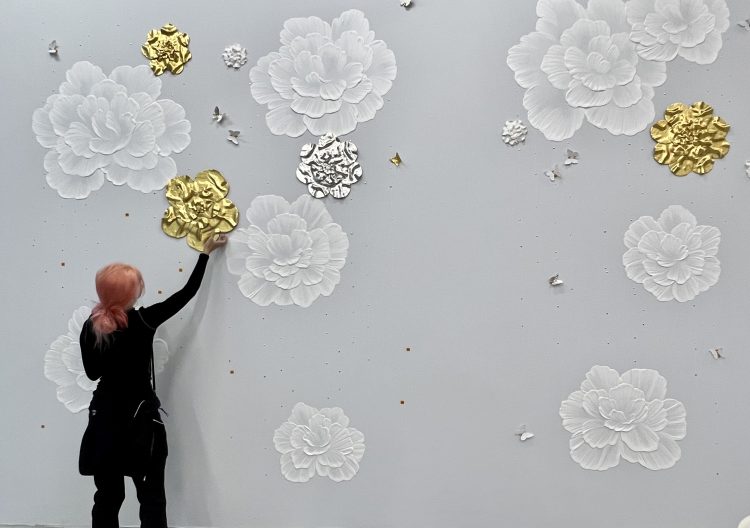
Image courtesy of MJ Atelier
This conversation had been edited for length and clarity.
Can you tell us a bit about the beginnings of your career and how you got into this specific discipline?
I was trained in New York City at the New York Academy of Art, about 40 years ago. And it was in its infancy. It was a pilot program and they were reviving the French academic art curriculum from the 17 and 1800s. After a predominance of abstract expressionism and commercialism through the 60s and 80s, it was refreshing to attend a school that was returning to classical foundation, emphasizing figurative art and technical skill and color theory and composition and geometry, all that. We were even dissecting human cadavers. It was like Renaissance training—nothing was spared. And I was working at the school at the time as well and Andy Warhol was on the board at the time. This was an extension of, I think, his belief that he came to a part in his career where he realized he lacked the foundational training. So, they spared no expense to give us the best training.
Aside from the training, they also had the beginnings of a bureau atelier teaching decorative techniques. The pivotal point for me was being given an opportunity to create something for the Kips Bay show house in, maybe, 1987? I was a student and I wandered into that house a couple of days before the big reveal and I saw some of the greats walking around and doing their thing. Mario Buatta was chair, Bunny Williams was running down the stairs and antiques were being ushered up the stairs. I just fell in love with the energy, the decorative arts world, and the interior design world. And I decided that that’s where I wanted to focus my skills.
“I’m not an artist creating in a vacuum and just saying, ‘Here are my things for sale.’ You’re actually going and finding out what interior designers are in need of.”
Were there any work experiences early on that were foundational to you?
When I graduated, I moved to Los Angeles, and I had enough formal training in wood grain and marbelizing and things like that that I got into working for professional art studios and creating painted furniture and objects for high end retail shops. Everyone has their own need for these particular skills, and so I found myself working in that industry and the film industry. And this is where I learned how to work fast, work smartly, and how to deal with interior designers and function in a way that you know works for them.
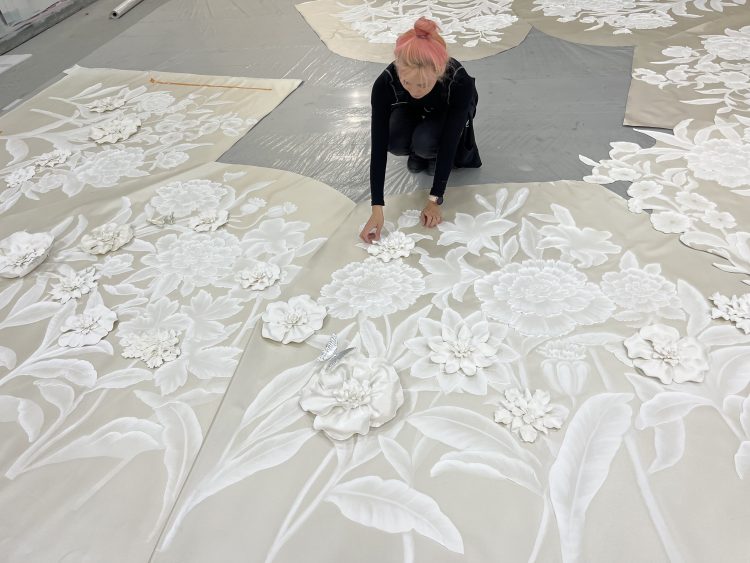
Image courtesy of MJ Atelier
And how is that unique?
I’m not an artist creating in a vacuum and just saying, “Here are my things for sale.” You’re actually going and finding out what interior designers are in need of, what is there a deficit of, and how can my skills apply to what you’re selling? So I really consider myself a byproduct of the furniture industry and the interior design industry.
So can you tell us about your process working with designers and architects?
From a technical aspect, it’s really quite simple. We just require elevations, it goes through a meeting, of course, they express what they want. We listen very closely, and hopefully we hit the mark. The creative process is always always different, though; it depends on the design team and whether they’re very clear and concise about what they want. Some are more open, and they give us carte blanche, which is a little bit more fun for us, but it’s also a lot of pressure to turn out right. For something like a showhouse, usually they come to us and say, “Okay, we know your product, what can you create in, like, two weeks?”
Would you say you have your own recognizable style, or are you always channeling your collaborator?
When we work with designers, we say “we are their brush.” So we are particular, definitely, and we have a certain skill, but we are not trying to create our own—that’s something you would go to a gallery for.
Speaking of skill, how do you go about finding employees who have these skills?
Because what we do is proprietary and it hasn’t existed before, we train most people. The preference is that they have some kind of skill and training, but I can usually tell from looking at someone’s drawings if they’re a good fit, because it’s a sculptural process.But that said, they come from all walks of life here. Some have art degrees, and some do not and they’re just great technically.
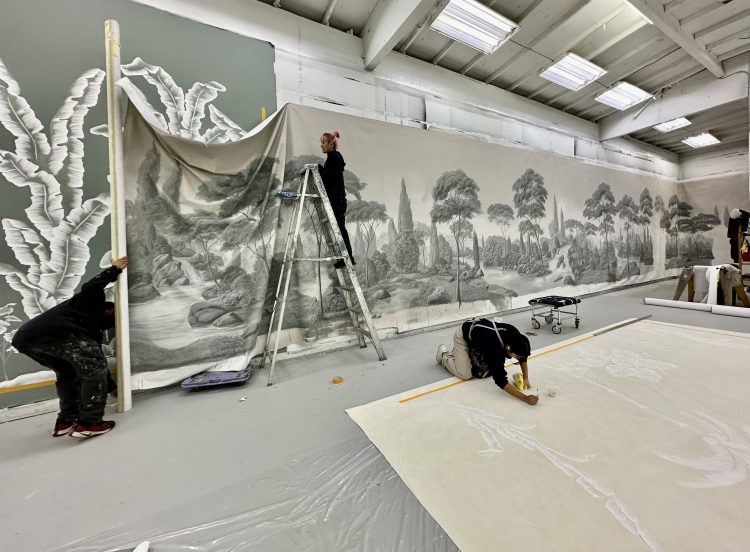
Image courtesy of MJ Atelier
Do you think it’s become harder to find these people?
Well, it takes years to do all the skills required in the decorative arts. It’s definitely a dying breed, and there is a propensity for digital arts; most of the people who come here are graduates of some form of digital. But one of the things that I am passionate about is keeping the decorative arts alive, because it will die if we don’t. Gilding, glass, faux painting, mural painting—all of these are skills that are gained over years and years, and you need experience to be able to become good at it. Designers need to keep ordering this kind of stuff to keep it alive.
“Designers will say, ‘Oh, I love that book, but it’s just not in our budget.’ So then I go away and I try to develop things that will help with that issue.”
Conversely, I’m sure there are some ways in which technology and the digital realm has made work easier for you.
My process of design is definitely made much faster because of technology, and also technological advancements in paint have allowed us to change the way we work. More recently, I’ve been developing an entire line of faux shagreen, and will branch out into other things that are hard to get on the market now.
How cool. It sounds like you are definitely always experimenting; how do you encourage yourself to keep developing new techniques?
I look at what designers are using at the moment, what costs a lot. With the shagreen, for example, we ended up with a shagreen table to create, and we got loads of skins and I thought, “how sad that we have to kill all these creatures to have this look—there must be a different way.” So that’s where I start, with things that are rare, or hard to get—tortoise shell, inlay ivory. I start to poke around. Things that are big expenses, too. Designers will say, “Oh, I love that book, but it’s just not in our budget.” So then I go away and I try to develop things that will help with that issue.
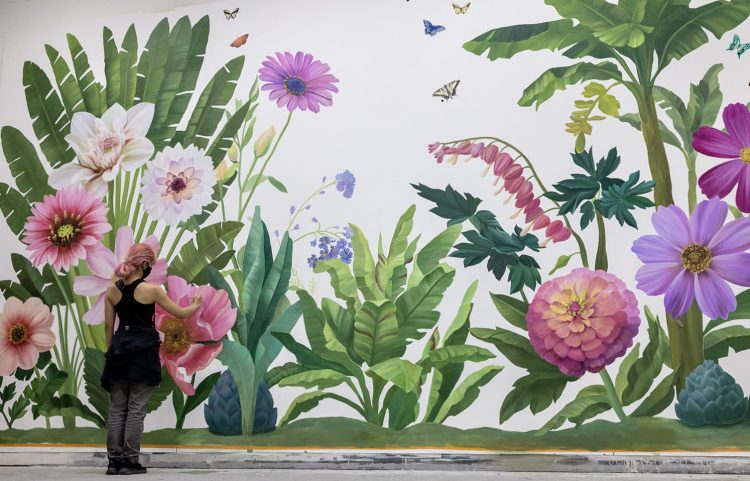
Image courtesy of MJ Atelier
Are there any projects that stand out as being especially challenging?
Oh yeah [laughs]. Recently, we’ve been designing for some Vegas hotels and just the scope of the projects are very, very large. There’s the engineering of things: How are you going to get that done in this short span of time? And then of course, they want to explore new ideas, things that have not been seen. I think this is true of almost all designers in the field. There’s a penchant for what’s new and hasn’t been seen. And can it be seen in my vision?
I love to hear your work is being supported by those bigger groups; have you noticed a shift towards larger hospitality groups investing in handmade and bespoke craft?
Yeah, absolutely. In fact, we just had a case where a client rejected proposals for some mirrors made with a machine-made process; they can pick up the machine made in an instant, and they say, “We absolutely don’t want that.” They had this idea that just because they were ordering a lot, they didn’t want to move to the fastest process. So there is this move backwards into the warmer handmade feeling that’s missing from all the printed and the generic, more cost effective options out there.
So in your workshop, how are things organized? By discipline? By project?
We have about 13 employees, and it is different every day. One day, the walls will be blanketed with something and there will be glass being painted in the middle of the floor. And then the next month there might be a huge piece of furniture or a custom bar being fitted below the floor. The turnover here is very, very fast. We are pretty large and we can even expand larger, but really ultimately you only have a certain number of hands to be able to work on everything.